AI Content Strategy: The Future of Marketing for 2025 Success
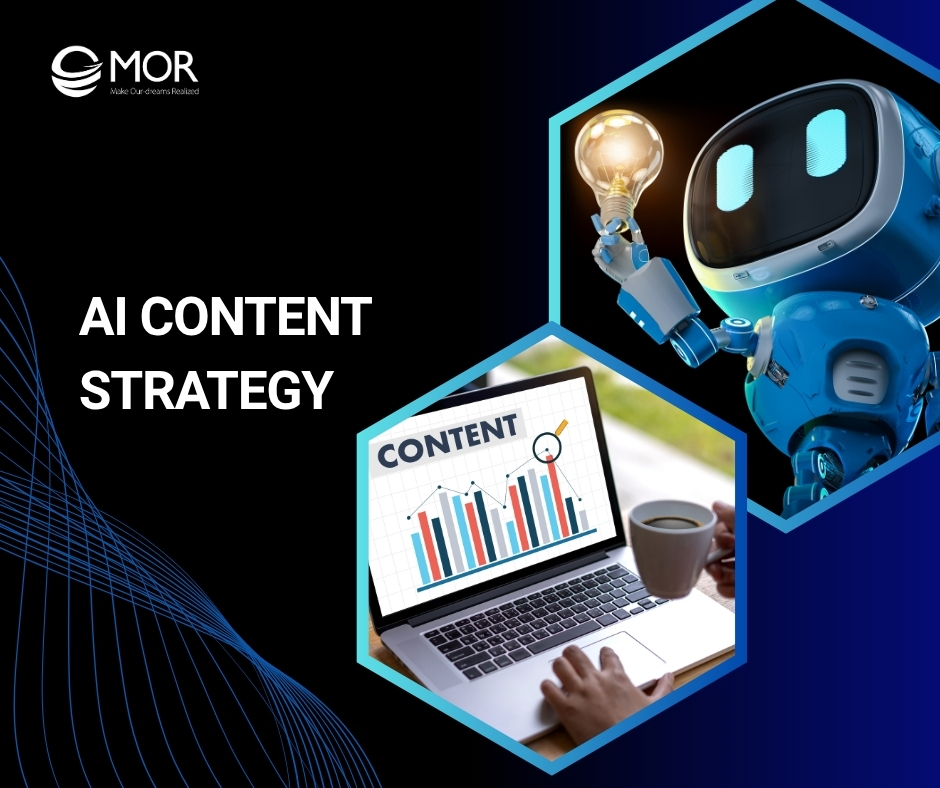
AI is changing how brands plan, create, and publish content, but not every company knows how to make it work. A clear AI content strategy helps teams produce smarter, more personalized, and data-driven stories that actually connect. This MOR Software’s guide will show how to use AI to build a balanced, authentic content strategy that drives real business value.
What Is An AI Content Strategy?
An AI content strategy is a data-driven plan that uses AI automation to manage every stage of content production, from research to delivery. It helps teams analyze trends, generate ideas, create drafts, and refine SEO faster than traditional methods. The purpose is simple: increase content quantity and quality while saving time and resources. With AI, brands can publish smarter, more consistent, and more engaging content at scale.
That shift is already happening. IBM reported that 42% of enterprise-scale companies have actively deployed AI and another 40% are experimenting. This is a signal that AI-led content operations are moving from pilot to practice.
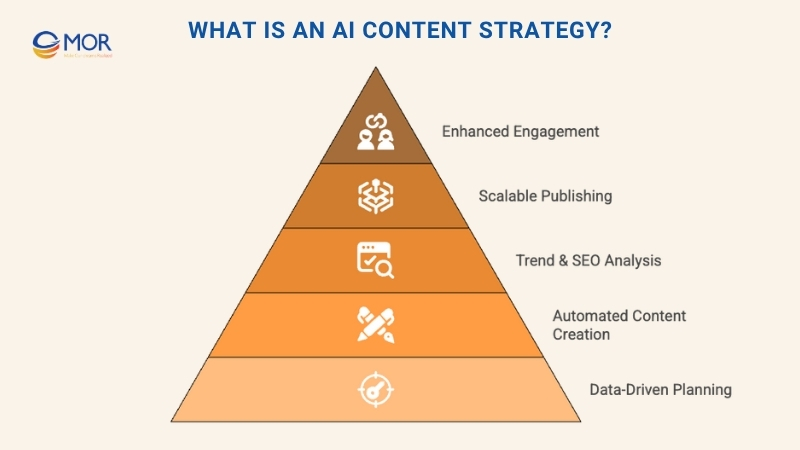
Key Benefits Of Adopting An AI Content Strategy
Adopting an AI content strategy helps teams work smarter, not harder. It improves speed, accuracy, and personalization, turning content creation into a scalable, data-driven process that consistently delivers stronger results. Early adopters of AI agent frameworks are already seeing real benefits. About 66% of organizations using them say productivity has gone up, and more than half also notice lower costs and quicker decisions.
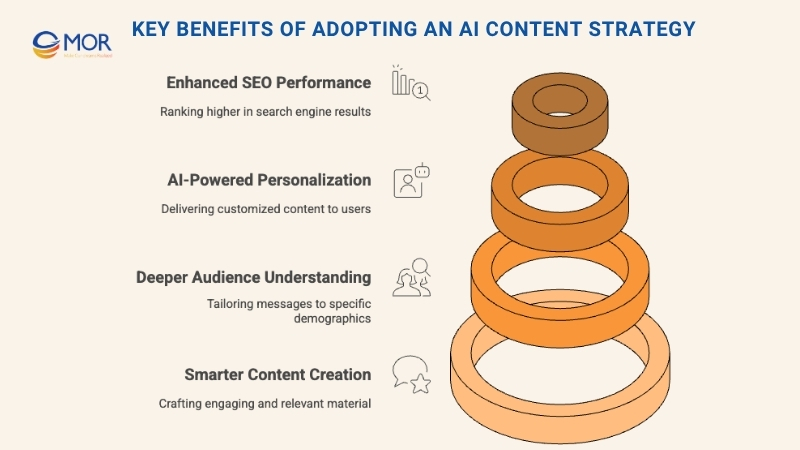
Smarter Content Creation
With an AI content strategy, teams can create content faster and more efficiently. AI-driven platforms produce outlines, first drafts, and topic ideas in minutes, freeing marketers to focus on creativity and unique insights. Deloitte Digital found that people using generative AI save about 11.4 hours each week. That extra time lets teams focus on creative ideas, editing, and improving the final message..
This balance between automation and human input helps brands maintain consistent publishing schedules without stretching resources.
Deeper Audience Understanding
Machine learning makes it easier to understand what audiences want. Through advanced analytics, AI automation tools process huge data sets to uncover patterns in user behavior and content performance. Salesforce found that about 68% of workers think generative AI will help them serve customers better. This shows how using data insights can lead to more personal and meaningful customer experiences.
These insights help shape more relevant stories, boosting engagement and conversion rates. In short, AI-driven marketing content turns raw data into direction, helping every post speak directly to the right people.
AI-Powered Content Personalization
Personalized experiences are now the heart of every AI content strategy. Smart tools like Klaviyo and HubSpot analyze user activity, interests, and purchase history to create content that feels tailor-made. McKinsey found that faster-growing companies earn about 40% more of their revenue from personalization compared to those that grow more slowly. This shows how tailoring content to each user can make a real difference in business results.
They group users by behavior, then deliver customized suggestions in real time across email, web, and social platforms. This kind of AI-powered content strategy not only increases engagement but also builds stronger loyalty and long-term trust.
AI For Better SEO Performance
Modern SEO has become faster and more precise thanks to artificial intelligence. Tools such as SEMrush, RankIQ, and SurferSEO act as intelligent assistants for marketers. They suggest keywords, track competitors, and recommend ways to improve content flow and readability.
BrightEdge estimates that organic search drives about 53% of all trackable website traffic, showing how powerful SEO still is compared to social or display ads. Since Google holds around 90.38% of the global search market, optimizing for search intent there remains the best way to stay visible online.
With an AI SEO content strategy generator, you can create articles that match search intent, improve rankings, and keep your brand visible across every platform.
Four Core Pillars Of A Successful AI Content Strategy
Building a scalable AI content strategy means combining structure, creativity, and data. These four pillars help teams produce high-quality content consistently while staying agile and aligned with business goals.
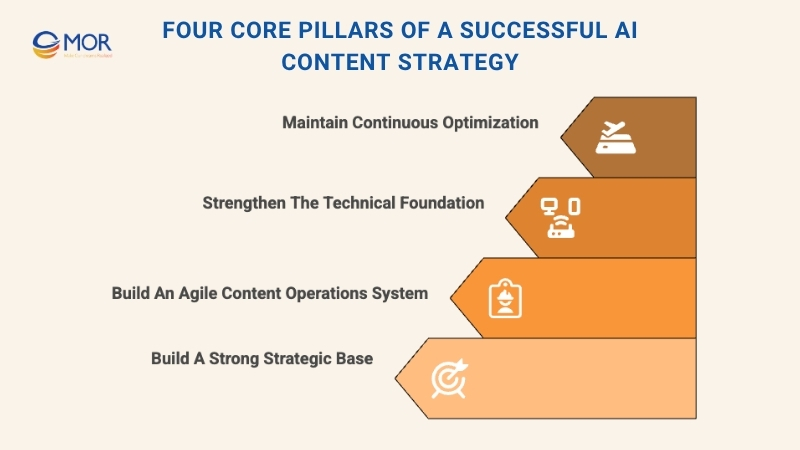
Pillar 1: Build A Strong Strategic Base
A strong strategy is the backbone of every successful AI-powered content strategy. Each piece of content should connect directly to your goals and audience expectations.
- Growth Content: Drives measurable results through landing pages, conversion blogs, and campaign assets.
- Authority Content: Builds trust with whitepapers, research pieces, and expert insights.
- Innovation Content: Experiments with formats, tools, and ideas to identify new growth paths.
Plan your content mix wisely. Focus most of your efforts on primary channels that convert, strengthen visibility through secondary ones, and leave room for testing emerging spaces. Using audience intelligence tools from content strategy software helps map customer pain points and journey stages, ensuring every piece of content fits a clear purpose.
Pillar 2: Build An Agile Content Operations System
A scalable AI content strategy depends on smooth operations. Blending automation, human creativity, and performance insights keeps workflows fast and reliable.
- Automated Base: Use AI diversity to handle repetitive tasks like formatting, tagging, and publishing so teams can focus on creativity.
- Human Insight: Keep editors and strategists in charge of storytelling, tone, and alignment with brand voice.
- Performance Layer: Track progress using analytics, then refine based on what drives engagement and conversions.
Automation removes bottlenecks while maintaining flexibility. Combined with AI for content creation, this approach keeps operations efficient and adaptable to changing priorities.
Pillar 3: Strengthen The Technical Foundation
A successful AI content strategy relies on a connected and data-driven setup. When tools and systems communicate smoothly, teams can collaborate better and make faster, smarter decisions.
- Link creation, optimization, and publishing tools into one continuous workflow.
- Remove data gaps to keep audience insights synchronized across enterprise AI platforms.
- Apply quality checks and performance tracking from start to finish.
A unified infrastructure keeps your strategy scalable and consistent. With strong integration and enterprise content optimization, every system works together to support automation, insight sharing, and real-time improvement.
Pillar 4: Maintain Continuous Optimization
The best AI content strategy is never static. Successful teams rely on constant testing, measurement, and improvement to stay ahead.
- Track operational metrics like publishing speed and workflow accuracy.
- Measure performance outcomes through traffic, conversions, and engagement rates.
- Build feedback loops with regular audits and team reviews to keep content fresh and aligned.
These habits turn small adjustments into lasting growth. With consistent iteration and the support of AI content optimization, your strategy becomes smarter and more scalable, ensuring every piece of content performs better over time.
How To Build An AI-Driven Content Strategy: 6 Practical Prompts
Building an effective AI content strategy starts with the right prompts and processes. These six practical steps show how to combine data, creativity, and AI tools to create content that connects with your audience and drives real growth.
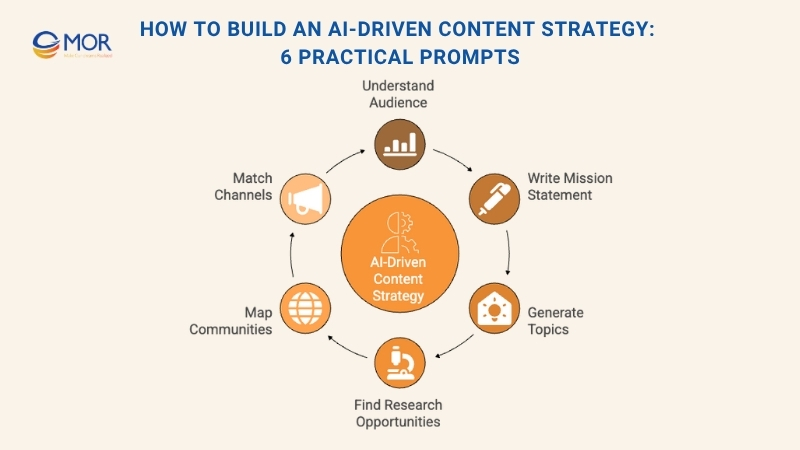
1. Understand Your Audience With AI
Every effective AI content strategy starts with empathy. Before creating anything, you need to know your audience inside out. The better you train AI on your ideal customers, the smarter and more accurate its responses will be.
There are two main ways to do this:
- Upload your existing personas or ideal client profiles (ICPs).
- Use AI as a service to generate a detailed persona from scratch.
Once you’ve reviewed and refined the result, the AI can act like a virtual version of your target reader. You can then ask what they search for, which topics interest them most, or what type of content earns their attention. Accuracy is key here, train the system carefully and keep refining.
Sample Prompt: “Generate A Draft Persona”
Build a detailed persona for a [job title] working in [industry/company size/location] responsible for [main duties/responsibilities]. This person struggles with [specific challenge/problem] and is exploring [product/service] as a solution.
- What goals drive them to solve this issue?
- What concerns might hold them back from deciding?
- Which emotional triggers would push them to act?
- What factors do they weigh when comparing vendors or partners?
Once generated, review it for realism and tone. This single step often reveals insights even customer interviews might miss, and it lays the foundation for a stronger AI-driven marketing content plan.
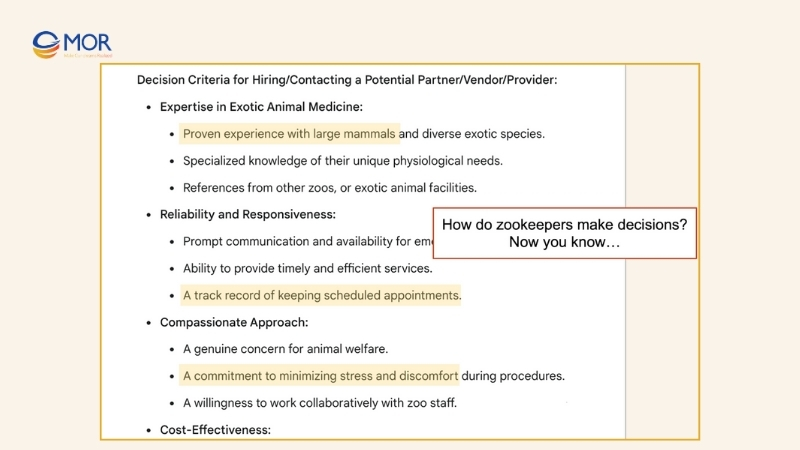
After refining, save your persona as a file or integrate it directly into your AI vs ML vs DL tools. You can also turn it into a custom ChatGPT, Gemini Gem, or Claude Project so your team can reuse it across campaigns.
Until you’ve trained AI on your audience, it’s just guessing. Without personas, AI equals Average Information. Take time to teach it who you’re talking to before moving on to topic creation.
2. Write A Content Mission Statement Using AI
Let’s build the foundation of your AI content strategy with a clear mission statement. This short statement defines your purpose, who you’re talking to, what topics you’ll cover, and why it matters to them. It keeps your strategy focused, consistent, and aligned with business goals while making it easier to create persuasive signups or calls to action.
Start by feeding your AI the audience persona you just built. Then use this structured prompt to guide it:
Sample Prompt: “Generate A Draft Content Mission”
You are a skilled content strategist focused on building audience trust and attracting qualified leads. Based on the provided persona, write a content mission statement that reflects their goals and challenges.
A strong content mission statement should include:
- Target audience: Who will benefit from the content?
- Key topics: What subjects or challenges will you address?
- Reader value: What benefit, insight, or solution will they gain?
Once written, create three personalized newsletter CTAs that match the persona’s interests and encourage subscriptions. Make each one actionable and specific.
This detailed prompt gives big data machine learning a strong framework rooted in real marketing strategy. It’s also a great training tool for junior writers learning how to align content with audience intent.
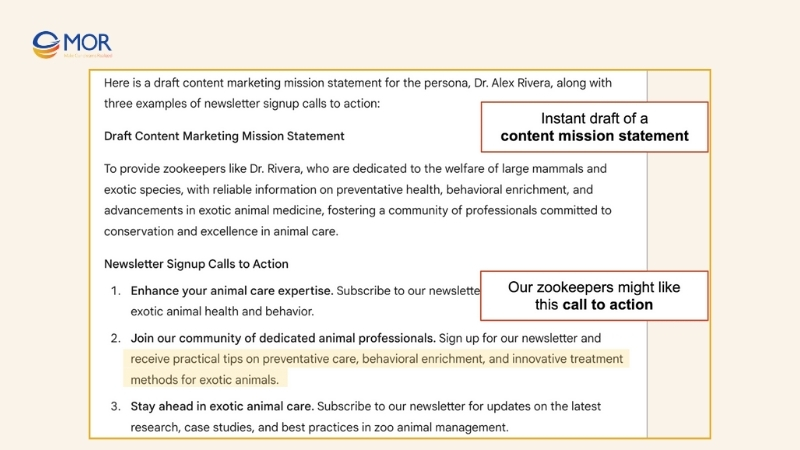
The first AI output will likely be solid, but it still needs a human touch. Edit for tone, accuracy, and specificity, generic CTAs like “Sign up for our newsletter” won’t cut it. A refined mission statement can double as a strong AI-powered content strategy guideline and a conversion driver for your campaigns.
Once that’s in place, you’re ready to explore creative topics. Transfer learning is especially useful here, most marketers use it for idea generation and refinement rather than full content writing. Studies show topic ideation remains the top use case in AI-assisted marketing, proving its growing role in shaping smarter, more effective strategies.
A quick glance across the web reveals how repetitive most content has become. It lacks originality, either blending into the crowd or repeating familiar insights. The only formats that truly set brands apart are original research and strong opinions, the kind of content that defines thought leaders in any field. We’ll explore both next.
3. Generate Engaging Social Media Topics
Great conversations, online or offline, start with opinions. A strong point of view draws attention, invites reactions, and fuels discussion. That’s why opinion-based posts are so powerful in social media. They make people respond, and those responses signal the machine learning algorithm to boost visibility.
Not every post needs to be thought leadership, but true thought leadership always takes a stand. If your readers can’t disagree, it’s not thought leadership. In a world where AI content strategy often produces generic posts, brands that share authentic opinions instantly stand out. AI can’t care about your industry, but you can.
Let’s use AI to brainstorm ideas that spark engagement without controversy, simple yet debatable topics that get people talking.
Sample Prompt: “Provocative But Simple Topics”
List several everyday or lightly debated topics within the [persona’s industry] that professionals often have strong opinions about.
Focus on subjects that aren’t divisive but still inspire discussion, comparison, or humor.
The goal is to encourage friendly debate and active engagement on social media.
Here’s what AI might produce based on a sample persona:
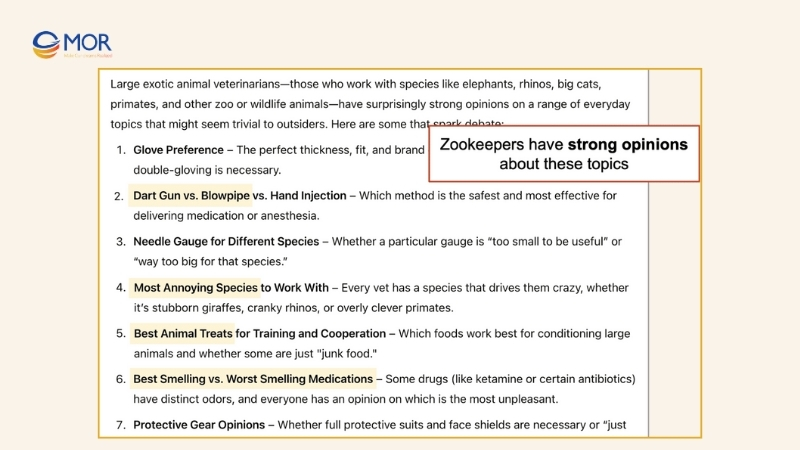
These kinds of small but relatable debates, like choosing tools, methods, or preferences, tend to perform best. They encourage comments, shares, and lighthearted arguments, which is perfect for social engagement.
When used thoughtfully, this tactic strengthens your AI-powered LinkedIn content strategy, positioning your brand as both approachable and opinion-driven. It’s a simple, human way to stand out in a feed full of AI-written sameness.
4. Use AI To Find Original Research Opportunities
Original research is one of the most effective ways to set your AI content strategy apart. When you publish unique data and share your analysis, your brand becomes a primary source, something every journalist and marketer values. These studies often earn backlinks, media mentions, and long-term SEO growth, making research-driven content the backbone of many successful campaigns.
For publishers, this approach is especially valuable. A well-structured AI content strategy for publishers helps identify new stories, uncover data trends, and produce credible insights that attract both readers and media attention.
AI can help uncover what’s missing in your industry’s existing research. The goal is to find a data point that surprises people, challenges assumptions, or validates claims no one has backed up before.
Sample Prompt: “Find Original Research Topics”
You are an experienced content strategist aiming to create original research that attracts backlinks and press coverage. Identify key topics in the [persona’s industry] that lack reliable statistics or supporting evidence.
- What statements or beliefs are commonly repeated but rarely proven?
- Which areas could use updated or more specific data?
- How can this research provide value to journalists, editors, and industry professionals seeking credible sources?
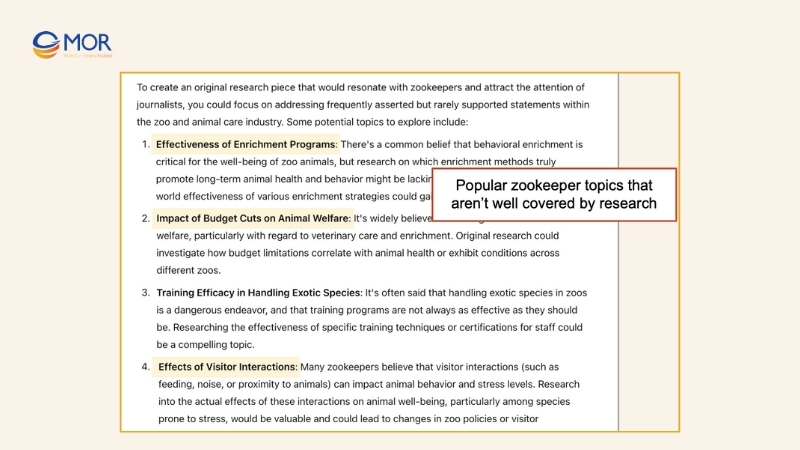
Not every study requires big budgets or academic rigor. Even small surveys or internal data analyses can reveal meaningful trends that others will cite. If full-scale research isn’t possible, consider using data storytelling, turning customer insights or usage patterns into valuable content.
Collaborating with industry groups or partners can strengthen credibility, especially for brands looking to build authority in competitive markets. For teams focusing on regional growth, this approach forms a strong foundation for an AI content strategy news Asia 2025, helping local insights reach a global audience.
5. Map The Online Communities Your Audience Follows
AI can do more than generate ideas, it can also reveal where your audience actually spends time. Knowing where they engage helps you decide which channels to prioritize, which events to join, and which publications to pitch. The goal is simple: meet your audience where they already are.
Use AI to identify these digital and physical “watering holes,” from niche forums to industry events. A focused search will uncover the spaces where your ideal customers learn, share, and connect.
Sample Prompt: “Find Audience Communities”
You are a skilled content strategist familiar with the attached persona and their professional habits. Identify a list of specific communities, online and offline, where this audience interacts, learns, and exchanges ideas.
Create a table with categories (e.g., forums, associations, events, groups, podcasts, webinars, or trade platforms) and list the actual community names under each. Be as specific as possible to help guide outreach and engagement planning.
Here’s an example output for a sample persona:
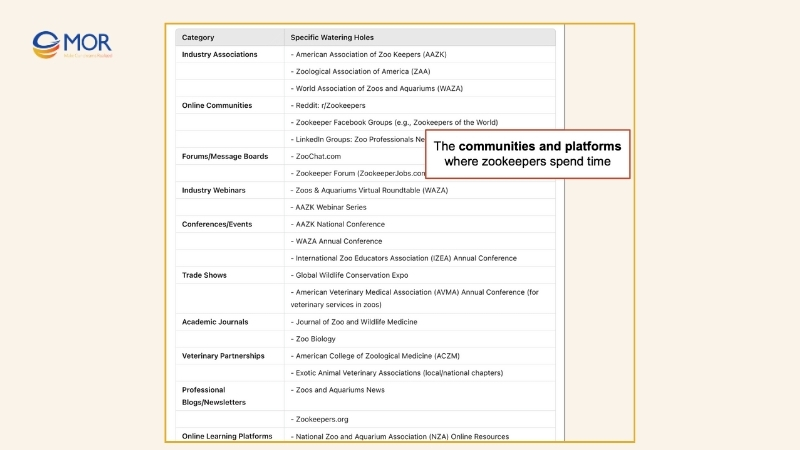
Once you have this list, explore how each platform functions.
- Which topics get the most engagement?
- What kind of discussions drive interaction?
- Which influencers or thought leaders dominate those spaces?
- Which publishers or brands already have strong visibility there?
With an hour of AI-assisted research, you’ll know exactly where to listen, connect, and collaborate. This insight can guide PR outreach, event partnerships, or influencer marketing. For regional brands, it’s an essential step toward refining your AI analytics social media content strategy benefits, helping you connect with your audience in the spaces they trust most.
6. Match Topics With The Right Promotion Channels
A smart AI content strategy isn’t just about what you publish, it’s about where it performs best. Every channel has its own rhythm. Search users want clear answers fast. Social media users prefer visuals, emotion, or surprise. Knowing this difference helps you plan topics that fit the right context.
With AI, you can analyze past performance to see what works where. Export your GA4 “Pages and screens” report filtered by blog URLs, remove direct traffic, and include metrics like sessions, engagement rate, and time on page. Then upload the cleaned CSV to your AI tool for analysis.
Sample Prompt: “Align Topics With Channels”
You are a content strategist with expertise in analytics and performance optimization. Review this GA4 report showing traffic and engagement for blog content by channel.
Based on the data, suggest 10 future content topics aligned with the channels where they are most likely to perform well. Include a brief promotion idea for each topic.
[upload GA4 report]
Once processed, AI will highlight which topics thrive on search (evergreen, how-to guides) versus those that perform better on social platforms (visual, storytelling, or emotional hooks).
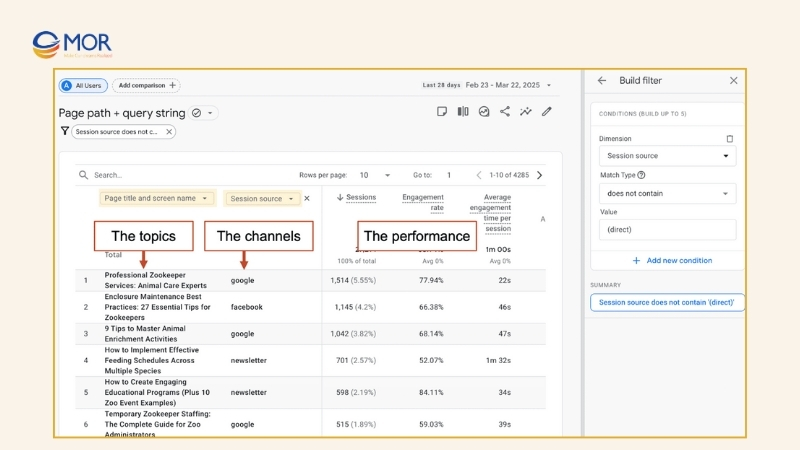
The analysis might look something like this:
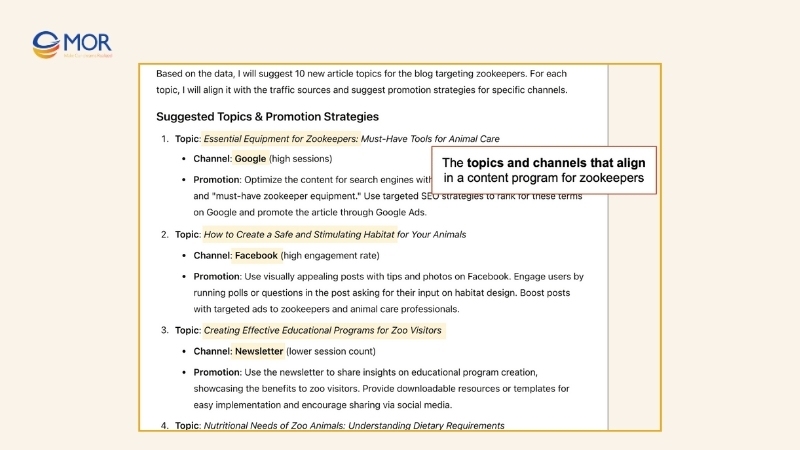
The output gives you a channel-based roadmap for future campaigns. You’ll see which ideas fit SEO, which work best on LinkedIn or YouTube, and how to promote them effectively. It’s a simple but powerful way to use data to refine distribution before writing even begins.
This approach keeps your AI SEO content strategy generator grounded in performance, not guesswork, helping your team plan smarter, publish faster, and reach audiences where they’re most active.
Best Practices For Implementing An AI-Driven Content Strategy
Adopting AI isn’t just about adding another tool to your stack, it’s about reshaping how your team plans, creates, and measures content. These best practices will help you integrate AI effectively and turn it into a long-term advantage.
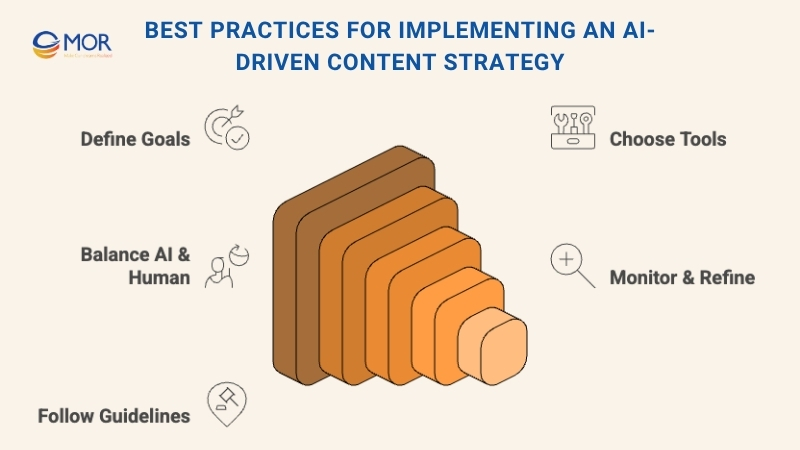
Define Clear Goals And Use Cases
Every AI content strategy needs direction. Start by identifying what you want to achieve, more content, smarter personalization, stronger SEO, or faster turnaround. Concrete goals make AI adoption measurable and meaningful.
For instance, you might begin by using AI for topic ideation or keyword clustering to boost output. Set a clear target, such as publishing 50% more blog posts next quarter. Once you’ve tracked the results, expand into more advanced use cases. This step-by-step approach ensures that AI delivers measurable value from the start.
Choose The Right Tools For Your Needs
Machine learning models vary widely in quality and purpose. Pick solutions that fit your goals and audience. A brand focused on enterprise software might need tools tuned for technical writing, while retail marketers might prioritize visual and product-focused platforms.
Research carefully, compare features, and test free versions before committing. Some platforms specialize in automation, others in AI for content creation or predictive analytics. The goal is to find the right mix that supports your workflow and complements your team’s creativity, not replaces it.
Balance AI Power With Human Creativity
AI brings speed and precision, but it can’t replace human intuition. The strongest AI content strategy blends automation with creative insight. Let AI handle data-heavy work like research, analysis, and draft creation, while people focus on storytelling, emotional tone, and brand consistency.
Build workflows that keep both sides connected. For example, use AI to create outlines and rough drafts, then let writers refine structure, voice, and depth. This balance ensures efficiency without losing authenticity, the key ingredient that makes content feel real.
Monitor And Refine Constantly
AI-driven content needs ongoing attention. It’s not a “set and forget” system. Track how your AI-generated pieces perform, compare engagement, conversions, and SEO results to your usual benchmarks.
Run A/B tests to measure the difference between AI-assisted and human-only content. Gather feedback from editors and audiences, then adjust prompts or tone accordingly. Over time, these feedback loops turn your system into a smarter, more consistent engine for enterprise content optimization, aligning technology with your evolving brand goals.
Follow Legal And Ethical Guidelines
As AI takes a bigger role in content creation, regulations are catching up fast. A responsible AI content strategy requires transparency and compliance. Stay updated on new laws governing AI use in marketing automation cloud, especially when working in industries that handle personal data or sensitive information.
Set clear internal rules for how AI is used within your organization. Define when to disclose AI-generated content, how to review outputs for accuracy, and what checks are needed to avoid ethical or legal issues.
By building these safeguards early, your team can use AI confidently while keeping content trustworthy and compliant. The goal isn’t just to scale production, it’s to do so responsibly. With the right structure and oversight, AI-powered content strategy becomes a sustainable way to grow without compromising quality or integrity.
Future Trends In AI Content Strategy
The rise of artificial intelligence is transforming how brands create, distribute, and optimize content. But this is only the beginning. The next few years will bring faster tools, smarter systems, and new ways to personalize storytelling at scale. Here are some emerging trends shaping the future of AI content strategy.
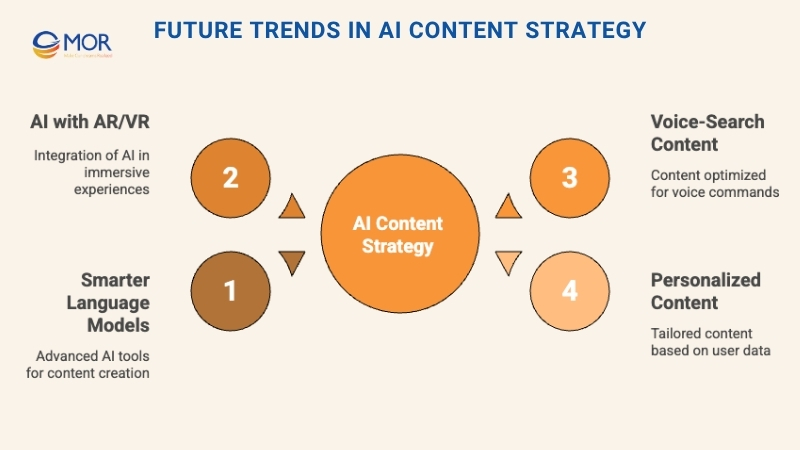
Smarter Language Models And Writing Tools
Natural language models are advancing fast, learning to write with greater accuracy, tone awareness, and depth. Soon, AI will handle longer, more complex content, like white papers, reports, or full campaign scripts, with minimal human editing. These tools will redefine how teams plan and produce content, helping them work faster without losing creativity.
Companies such as OpenAI and Google continue to lead this progress, developing models that can understand context, emotion, and brand voice better than ever.
Tip: Keep an eye on new-generation NLP tools and experiment early. Test them for efficiency and quality, but always let human judgment guide the final message. Smart adoption, not blind reliance, is what separates a good strategy from a great one.
Merging AI With AR and VR Experiences
The next wave of AI content strategy will extend beyond screens. Artificial intelligence is now merging with augmented reality (AR) and virtual reality (VR), transforming how audiences interact with brands. Imagine AI-driven virtual assistants guiding shoppers through immersive VR stores, or AR experiences that adapt in real time based on a user’s location or behavior.
These technologies will blur the boundaries between digital and physical engagement, turning content into a fully interactive experience. For marketers, this means designing campaigns that don’t just inform, but let audiences explore, react, and connect in entirely new ways.
Voice-Search And Conversational Content
Voice interaction is quickly becoming a standard part of daily life. With billions of digital voice assistants projected to be in use worldwide, brands must prepare for voice-first communication. AI helps marketers adapt by analyzing how people speak and search differently when using voice.
The future of AI-powered content strategy will emphasize natural, question-driven writing that mirrors human speech. AI tools will play a major role in optimizing tone, phrasing, and timing so that content performs well on platforms like Alexa, Siri, and Google Assistant. In this voice-led era, conversational storytelling will be key to staying discoverable and relevant.
Predictive And Hyper-Personalized Content
The future of AI content strategy is personal, deeply personal. With advanced data modeling, AI can analyze user behavior, preferences, and interactions to predict what someone wants to read, watch, or buy before they even realize it.
Soon, we’ll see AI systems that generate customized articles, emails, or videos in real time, adapting tone, visuals, and messaging based on each user’s actions. This level of personalization will redefine engagement, driving stronger loyalty and higher conversion rates.
Yet, as automation grows smarter, the marketer’s role becomes more strategic. The focus will shift from repetitive production to creative direction, ethical oversight, and ensuring authenticity. Those who master this balance, combining predictive AI with a human touch, will lead the next era of AI-powered content strategy.
No matter how advanced technology becomes, one rule stays constant: great content still starts with genuine value for the audience.
Key Challenges In AI Content Strategy
While an AI content strategy offers major advantages, it also comes with challenges that require careful management. From ethics to data privacy, understanding these risks is key to keeping your content accurate, secure, and authentic.
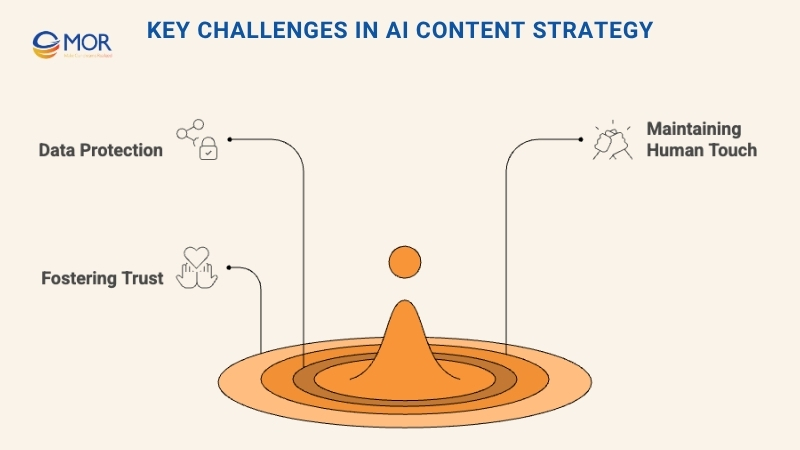
Ethical Responsibility
One of the biggest challenges in AI content strategy is ensuring fairness and transparency. AI systems can unintentionally reflect biases present in their training data, which may affect tone, inclusivity, or accuracy. Regular audits, diverse data sources, and human oversight help reduce these risks. The goal is to make sure your AI supports honest, balanced storytelling that aligns with your brand values.
Data Protection
Privacy must always come first. Since AI relies heavily on user data, protecting that data is non-negotiable. Use secure storage, anonymization, and compliance frameworks to meet privacy regulations and maintain user confidence. Building a trust-driven AI content optimization process not only protects your brand but also strengthens relationships with your audience.
Maintaining The Human Touch
Even the smartest AI content strategy needs a human heart behind it. Authenticity is what keeps content relatable and trustworthy.
- Treat AI as a creative assistant, not a replacement for human insight
- Always review and refine AI outputs to match your brand’s tone and intent
- Add your perspective, voice, and values to make each piece unmistakably yours
As industry experts often emphasize, the real strength lies in balance, using AI for speed and precision while letting human creativity shape emotion and connection. That’s how content stays engaging, genuine, and true to its purpose.
Case Study: Applying AI Content Strategy In Practice
So, what does a real-world AI content strategy look like when it’s done right? LinkedIn offers a standout example.
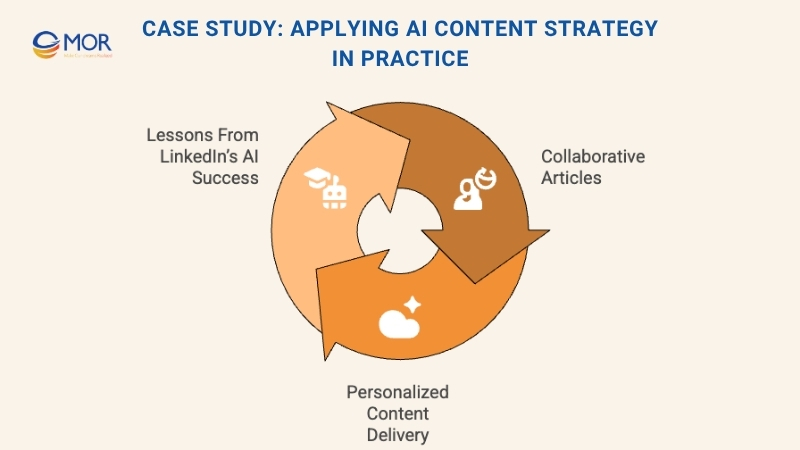
Collaborative Articles: Where AI Meets Human Expertise
LinkedIn has taken a bold step by combining AI’s analytical power with the knowledge of its global professional community. Their “Collaborative Articles” feature is a model of how human insight and automation can work together.
Here’s how the process flows:
- AI scans trending topics and drafts initial outlines on subjects relevant to professionals.
- Human experts then refine, expand, and add their perspectives.
- The finished articles are published and opened for community input, inviting members to share their insights.
This balance between data-driven content and human judgment ensures accuracy, diversity, and depth. AI identifies opportunities, but people give the content its voice and credibility.
Since launching the initiative, LinkedIn has seen sharp increases in engagement and interaction. The platform now delivers a steady stream of timely, insightful articles that reflect both machine intelligence and genuine human expertise, a true reflection of an AI-powered content strategy done right.
Personalized Content Delivery
LinkedIn’s AI content strategy goes beyond creation, it focuses on precision distribution. The platform uses machine learning to match each piece of content with the people most likely to engage with it.
Here’s how it works:
- AI studies user data, including job roles, interests, and engagement history.
- It predicts which articles or discussions will resonate most with each user.
- Personalized recommendations are then pushed through feeds, alerts, and email updates.
This proactive delivery method ensures that valuable content doesn’t get buried. Instead, it finds the right audience at the right moment.
The result: LinkedIn has seen measurable growth in engagement and time spent on the platform, proving that well-executed personalization is a cornerstone of modern AI-driven marketing content.
Lessons From LinkedIn’s AI Success
- Blend AI and human expertise: LinkedIn proves that automation works best when it supports, not replaces, human creativity and insight.
- Use what makes your brand unique: LinkedIn’s strength lies in its professional network. Find your own core advantage and let AI amplify it.
- Prioritize user relevance: Every decision in LinkedIn’s AI content strategy centers on delivering timely, valuable, and personalized experiences.
- Keep learning and improving: Their AI systems evolve continuously, using real-time engagement data to refine content recommendations and delivery.
LinkedIn’s example shows that winning with AI isn’t just about technology. It’s about balance, integrating smart tools into a broader vision that puts people first. When aligned with clear goals and authentic storytelling, an AI-powered content strategy can turn ordinary marketing into a dynamic, data-informed growth engine.
Partner With MOR Software For AI Content Strategy Success
At MOR Software, we help businesses turn AI-driven strategies into real-world results. As one of Vietnam’s Top IT outsourcing companies in Vietnam and a multiple Sao Khue Award winner, we combine software development expertise with data intelligence to power modern digital transformation.
Our AI content strategy solutions are built on a foundation of technology and experience. We integrate advanced automation, analytics tools, and personalization into your content systems, helping you plan smarter, create faster, and engage customers with precision. Whether it’s developing a content management platform, automating SEO workflows, or building custom AI solutions, our team ensures every solution aligns with your brand goals.
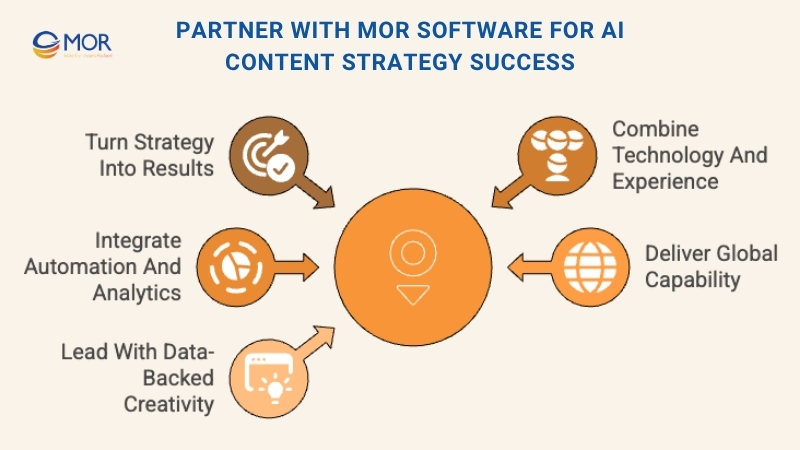
With offices in Vietnam and Japan, MOR Software delivers global capability with local understanding. Our engineers and consultants specialize in web, mobile, salesforce consulting, and cloud development, allowing seamless connection between your marketing platforms and backend systems. From idea to deployment, we focus on building scalable solutions that enhance content performance and long-term business growth.
Partner with us to create an AI content strategy that goes beyond automation. We’ll help you turn insights into impactful stories, strengthen audience engagement, and lead with data-backed creativity.
Contact us to discuss how MOR Software can bring AI innovation to your content strategy.
Conclusion
AI is reshaping how businesses approach content, turning data into direction and automation into opportunity. A well-defined AI content strategy helps brands stay consistent, relevant, and ahead of competition. With the right tools and partners, you can create content that performs smarter and connects deeper. MOR Software is here to help you make that shift, combining technology, insight, and creativity to drive real results. Contact us to start your AI transformation today.
MOR SOFTWARE
Frequently Asked Questions (FAQs)
What is an AI content strategy?
An AI content strategy is a data-driven approach that uses artificial intelligence to plan, create, distribute, and optimize content. It helps businesses produce more relevant, consistent, and high-performing content with less manual effort.
How does AI improve content marketing?
AI enhances content marketing by automating repetitive tasks, analyzing audience data, and generating insights for better decision-making. It helps marketers understand what topics perform best and how to personalize content at scale.
Why should businesses adopt an AI content strategy?
Adopting an AI content strategy saves time, cuts costs, and improves content accuracy. It ensures your marketing team focuses on creativity and strategy instead of spending hours on research and manual optimization.
What tools are used in AI-driven content strategies?
Popular tools include ChatGPT for ideation and drafting, Jasper for copywriting, SurferSEO for optimization, and SEMrush for keyword research. These platforms combine AI capabilities with data analytics to refine your strategy.
Can AI replace human writers?
No. AI supports content creators but doesn’t replace them. It handles tasks like topic generation, data analysis, and SEO optimization, while humans add creativity, empathy, and brand voice to make content authentic.
How does AI help with SEO content optimization?
AI analyzes top-ranking pages, identifies keyword opportunities, and suggests structure improvements. It can also track real-time performance metrics and recommend updates to maintain strong search visibility.
What are the main pillars of an effective AI content strategy?
The core pillars include strategic planning, streamlined operations, solid technical integration, and continuous performance improvement. Together, they create a sustainable and scalable content ecosystem.
How can AI personalize content for different audiences?
AI tools collect and analyze user behavior, interests, and demographics. They then use this data to deliver personalized recommendations, email content, and product suggestions that match each user’s preferences.
How do companies measure the success of their AI content strategy?
Success is measured through KPIs such as engagement rate, organic traffic, conversion rate, and content output efficiency. Many teams also monitor content velocity and performance consistency over time.
What are the challenges of using AI in content creation?
The main challenges include maintaining brand voice, ensuring data accuracy, avoiding plagiarism, and addressing ethical or bias concerns. Human oversight remains essential to control quality and integrity.
Is AI content strategy suitable for small businesses?
Yes. Small businesses can use AI tools to compete with larger brands by automating research, content production, and SEO tasks. Many AI platforms offer affordable plans designed for small teams.
How can AI assist in audience research?
AI helps identify audience segments, trending interests, and behavior patterns using analytics from multiple channels. It allows marketers to build detailed buyer personas and craft content that resonates deeply.
What industries benefit most from AI content strategy?
Nearly every industry benefits, but especially eCommerce, SaaS, healthcare, and finance. These sectors rely heavily on accurate, engaging, and data-backed content to reach their audiences.
How does AI ensure consistency across multiple content channels?
AI platforms manage workflows and maintain tone consistency by using brand-specific prompts and automated quality checks. They can track and standardize messaging across blogs, social media, and email campaigns.
Rate this article
0
over 5.0 based on 0 reviews
Your rating on this news:
Name
*Email
*Write your comment
*Send your comment
1